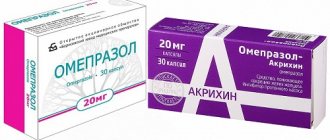Loperamide-Akrikhin caps 2 mg x20
Registration number: P N001229/01 Trade name of the drug: Loperamide-Akrikhin
International nonproprietary name: loperamide
Dosage form: capsules
Composition: 1 capsule contains: active substance - loperamide hydrochloride 2 mg, excipients: lactose (milk sugar), corn starch, colloidal silicon dioxide (Aerosil), talc, magnesium stearate. Capsule composition: titanium dioxide, quinoline yellow dye, sunset yellow dye, gelatin.
Description: Capsules No. 4 are yellow. The contents of the capsules are white or white-yellowish powder.
Pharmacotherapeutic group: antidiarrheal agent. ATX code: A07DA03.
pharmachologic effect
Pharmacodynamics Loperamide, by binding to opioid receptors of the intestinal wall (stimulation of choline and adrenergic neurons through guanine nucleotides), reduces the tone and motility of intestinal smooth muscles (due to inhibition of the release of acetylcholine and prostaglandins). Slows down peristalsis and increases the transit time of intestinal contents. Increases the tone of the anal sphincter, promotes fecal retention and reduces the urge to defecate. The action develops quickly and lasts 4-6 hours.
Pharmacokinetics When taken orally, absorption is 40%. Maximum plasma concentration is achieved 2.5 hours after taking the capsules. Bonding with plasma proteins (mainly albumin) is 97%. Does not penetrate the blood-brain barrier. Almost completely metabolized by the liver by conjugation. The half-life is 9-14 hours (average 9.8 hours). It is excreted mainly in bile, a small part is excreted by the kidneys (in the form of conjugated metabolites).
Indications for use Symptomatic treatment of acute and chronic diarrhea of various origins (allergic, emotional, drug, radiation, with changes in diet and quality food composition, with metabolic and absorption disorders, as an adjuvant for diarrhea of infectious origin). Regulation of bowel movements in patients with ileostomy.
Contraindications Hypersensitivity, intestinal obstruction, acute ulcerative colitis, diverticulosis, diarrhea due to acute pseudomembranous enterocolitis, dysentery and other gastrointestinal infections. Pregnancy (1st trimester), lactation period, children under 2 years of age (Loperamide-Akrikhin capsules are not prescribed to children under 6 years of age).
With caution: Liver failure.
Directions for use and dosage: Take orally, without chewing, with water. For acute diarrhea, adults are initially prescribed 2 capsules (4 mg) of Loperamide-Akrikhin, then 1 capsule (2 mg) after each bowel movement in case of loose stools. The highest daily dose is 8 capsules (16 mg). For chronic diarrhea, adults are prescribed 4 mg/day. The maximum daily dose is 16 mg. For acute diarrhea, children over 6 years of age are prescribed an initial dose of 2 mg, then 2 mg after each bowel movement in case of loose stools. The maximum daily dose is 4 capsules (8 mg). For chronic diarrhea, children over 6 years of age are prescribed Loperamide-Akrikhin in a daily dose of 2 mg. The maximum daily dose is 6 mg per 20 kg. After normalization of stool or in the absence of stool for more than 12 hours, the drug should be discontinued.
Side effects Observed, as a rule, only with long-term use of the drug. Possible allergic reactions (skin rash), drowsiness, dizziness, hypovolemia, electrolyte disturbances, dry mouth, intestinal colic, gastralgia, abdominal pain or discomfort, nausea, vomiting, flatulence. Rarely - urinary retention, extremely rarely - intestinal obstruction.
Overdose Symptoms: signs of depression of the function of the central nervous system (stupor, impaired coordination of movements, drowsiness, constriction of the pupils (miosis), increased skeletal muscle tone, respiratory depression), intestinal obstruction. Treatment: Naloxone is used as a specific antidote. Considering that the duration of action of Loperamide-Akrikhin is longer than that of naloxone, repeated administration of the latter is possible. Symptomatic treatment: gastric lavage, taking activated carbon (in the first 3 hours after taking the drug), artificial ventilation.
Special instructions If there is no effect after 2 days of using Loperamide-Akrikhin®, it is necessary to clarify the diagnosis and exclude the infectious genesis of diarrhea. Children under 6 years of age are not recommended to take capsules. If constipation or bloating develops during treatment, Loperamide-Akrikhin should be discontinued. In patients with impaired liver function, careful monitoring for signs of toxic damage to the central nervous system is necessary. During the treatment of diarrhea, it is necessary to replace the loss of fluid and electrolytes. During treatment, care must be taken when driving vehicles and engaging in other potentially hazardous activities that require increased concentration and speed of psychomotor reactions.
Release form Capsules 2 mg. 10 capsules per blister pack. 1 or 2 blister packs along with instructions for use are placed in a cardboard pack.
Storage conditions: In a dry place, protected from light, at a temperature not exceeding 25 °C. Keep out of the reach of children.
Shelf life: 4 years. Do not use the drug after the expiration date.
Conditions for dispensing from pharmacies Without a prescription.
Manufacturer/Organization accepting consumer complaints: Open Joint-Stock Company Chemical and Pharmaceutical Plant AKRIKHIN (JSC AKRIKHIN), Russia 142450, Moscow region, Noginsky district, Staraya Kupavna, st. Kirova, 29. Phone/fax
Oseltamivir-akriquin 75 mg 10 pcs. capsules
pharmachologic effect
Antiviral agent. It is a prodrug whose active metabolite (oseltamivir carboxylate) selectively inhibits neuraminidase of influenza virus types A and B. Neuraminidase is a glycoprotein that catalyzes the cleavage of the bond between terminal sialic acid and sugar, thereby facilitating the spread of the virus in the respiratory tract (the release of virions from the infected cell and penetration into epithelial cells of the respiratory tract, preventing inactivation of the virus by epithelial mucus). Oseltamivir carboxylate acts outside cells and competitively inhibits viral neuraminidase. Inhibits the growth of the influenza virus and suppresses the replication of the virus and its pathogenicity in vivo. Reduces the release of influenza A and B viruses from the body.
Composition and release form Oseltamivir-akrikhin 75 mg 10 pcs. capsules
1 capsule contains the active substance: oseltamivir phosphate 98.5 mg, equivalent to oseltamivir 75 mg.
10 capsules per package.
Description of the dosage form
Hard gelatin capsules No. 1, yellow cap, white body. The contents of the capsules are a mixture of granules and almost white powder or a compressed mass of almost white color, crumbling when pressed lightly.
Directions for use and doses
The drug should be taken no later than 2 days after the development of symptoms of the disease.
Adults and adolescents over 12 years of age: 75 mg 2 times a day orally for 5 days. Increasing the dose to more than 150 mg/day does not increase the effect.
Patients with creatinine clearance more than 60 ml/min do not require dose adjustment. In patients with a creatinine clearance of 30 to 60 mL/min, the dose of oseltamivir should be reduced to 30 mg twice daily for 5 days.
In patients with a creatinine clearance of 10 to 30 ml/min, the dose of oseltamivir should be reduced to 30 mg once daily for 5 days. For patients on chronic hemodialysis, oseltamivir at an initial dose of 30 mg can be taken before starting dialysis if flu-like symptoms appear within 48 hours between dialysis sessions. To maintain plasma concentrations at therapeutic levels, oseltamivir should be taken 30 mg after each dialysis session. For patients on peritoneal dialysis, oseltamivir should be taken at an initial dose of 30 mg before starting dialysis, then 30 mg every 5 days. The pharmacokinetics of oseltamivir in patients with end-stage renal failure (creatinine clearance &ge10 ml/min) not on dialysis have not been studied. In this regard, there are no dosage recommendations for this group of patients.
Indications for use Oseltamivir-akrikhin 75 mg 10 pcs. capsules
Treatment of influenza in adults and children over 1 year of age.
Prevention of influenza in adults and adolescents over 12 years of age who are in groups at increased risk of infection with the virus (in military units and large production teams, in debilitated patients).
Prevention of influenza in children over 1 year of age.
Contraindications
Hypersensitivity to oseltamivir phosphate or any component of the drug.
End-stage renal failure (creatinine clearance &ge10 ml/min).
Children's age up to 1 year.
Severe liver failure.
Application Oseltamivir-akrikhin 75 mg 10 pcs. capsules during pregnancy and breastfeeding
Use caution during pregnancy and breastfeeding.
special instructions
Seizures and delirium-like neuropsychiatric disorders have been reported in patients (mainly children and adolescents) taking oseltamivir for the treatment of influenza. These cases rarely involved life-threatening actions. The role of oseltamivir in the development of these phenomena is unknown. Similar neuropsychiatric disorders were also noted in patients with influenza who did not receive oseltamivir.
The risk of developing neuropsychiatric disorders in patients receiving oseltamivir does not exceed that in patients with influenza not receiving antiviral drugs. Careful monitoring of the condition and behavior of patients, especially children and adolescents, is recommended in order to identify signs of abnormal behavior and assess the risk of continuing to take the drug if these phenomena develop.
There are no data on the effectiveness of oseltamivir for any diseases caused by pathogens other than influenza A and B viruses.
Oseltamivir Canon is not a substitute for vaccination.
Prophylactic use of the drug Oseltamivir Canon is possible for epidemiological indications.
Oseltamivir in this dosage form should not be prescribed to children under 1 year of age.
Studies have not been conducted to study the effect of the drug on the ability to drive vehicles and engage in other potentially hazardous activities that require increased concentration and speed of psychomotor reactions. Based on the safety profile, the impact of oseltamivir on these activities is unlikely.
Side effects Oseltamivir-akrikhin 75 mg 10 pcs. capsules
In influenza treatment studies in adults/adolescents, the most common adverse reactions (APs) were nausea, vomiting, and headache. Most HP occurred on the first or second day of treatment and resolved spontaneously within 1-2 days. In influenza prevention studies in adults and adolescents, the most common HPs were nausea, vomiting, headache, and pain. Vomiting was the most common finding in children. The described HP in most cases did not require discontinuation of the drug.
Drug interactions
Clinically significant drug interactions are unlikely based on pharmacological and pharmacokinetic studies.
Oseltamivir phosphate is highly converted into an active metabolite by esterases, mainly located in the liver. Drug interactions caused by competition for binding to the active sites of esterases are not widely represented in the literature. The low degree of binding of oseltamivir and the active metabolite to plasma proteins does not give reason to assume the presence of interactions associated with the displacement of drugs from protein binding.
In vitro studies indicate that neither oseltamivir phosphate nor its active metabolite is a preferred substrate for polyfunctional cytochrome P450 oxidases or glucuronyltransferases. There are no reasons for interaction with oral contraceptives.
Cimetidine, a nonspecific inhibitor of isoenzymes of the cytochrome P450 system and competing in the process of tubular secretion with alkaline drugs and cations, does not affect the plasma concentrations of oseltamivir and its active metabolite. Clinically significant drug-drug interactions associated with competition for tubular secretion are unlikely, taking into account the safety margin for most of these drugs, the routes of elimination of the active metabolite of oseltamivir (glomerular filtration and anionic tubular secretion), as well as the excretory capacity of each of the routes.
Probenecid leads to an approximately 2-fold increase in the AUC of the active metabolite oseltamivir (due to a decrease in active tubular secretion in the kidneys). However, dose adjustment is not required when used concomitantly with probenecid, given the safety margin of the active metabolite.
Co-administration with amoxicillin does not affect plasma concentrations of oseltamivir and its components, demonstrating weak competition for elimination by anionic tubular secretion.
Concomitant use with paracetamol does not affect plasma concentrations of oseltamivir and its active metabolite or paracetamol.
Pharmacokinetic interactions between oseltamivir and its main metabolite were not detected when taken simultaneously with paracetamol, acetylsalicylic acid, cimetidine, antacids (magnesium and aluminum hydroxide, calcium carbonate), warfarin, rimantadine or amantadine.
In phase III clinical trials, oseltamivir was administered with commonly used drugs such as ACE inhibitors (enalapril, captopril), thiazide diuretics (bendroflumethiazide), antibiotics (penicillin, cephalosporins, azithromycin, erythromycin and doxycycline), histamine H2 receptor blockers (ranitidine, cimetidine). ), beta-blockers (propranolol), xanthines (theophylline), sympathomimetics (pseudoephedrine), opiates (codeine), corticosteroids, inhaled bronchodilators and non-narcotic analgesics (acetylsalicylic acid, ibuprofen and paracetamol). No changes in the nature or frequency of adverse events were observed.




